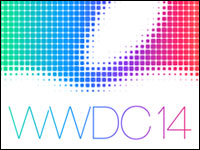
While there were two hours jam-packed with announcements at the keynotepresentation kicking off Apple’s Worldwide Developers Conference thisweek, you can count the really important announcements that willcreate lasting change on one hand. The new programming language, Swift,isn’t one of them. Wait, what? Not Swift? Why?
Swift is a tool that will help developers build better applicationsfaster. When we’re talking about a billion apps, app development isn’tcreating a bottleneck for Apple success or consumer enjoyment. There are fivebigger deals that will spark broader reach.
No. 1: iCloud
In some ways, Apple’s iCloud storage and app communicationservice is playing catch-up to the likes of Dropbox — but in other ways,it’s become so baked into the Apple experience that it is morecapable than ever of serving two masters: consumers anddevelopers.
For consumers, Apple has added iCloud Drive, which will let you storeany file in Apple’s cloud and access it on any device, including one runningWindows — like Dropbox, basically. For millions of Apple customers,iCloud Drive will become the first — if not the default — online cloudstorage choice.
Furthermore, apps that use iCloud get folders andvisible storage space on a customer’s iCloud Drive, too. As you edit adocument on one device, your changes will sync automatically for alldevices, allowing for seamless document editing with differentdevices in different places. It gets better, though: You can startediting in one app and add finishing touches in another appaltogether.
That’s just for files, though. There’s more to iCloud.
For instance, with the new Handoff feature, you can do thingslike start writing an email on your iPhone and pick up where you leftoff when you get on your Mac. Or browse the Web on your Mac and thencontinue on the same site on your iPad. Developers, it turns out, willbe able to use Handoff, too; it will let them build continuity integrationinto apps for different devices.
What this means is an easy, seamless experiences for mere mortals.
There’s even more, though: Apple’s new CloudKit for developers includesAPIs they can use to add common cloud-oriented services to theirapps without needing to use cloud services from other companies — andget this, it’s effectively free for the vast majority of developersand apps. This will speed app development in a big way.
No. 2: Photos
The iPhone is already the world’s most popular camera, but photomanagement remains a pain in the butt. Many iPhone users simply leavethousands of photos and videos on their iPhones, only moving them offwhen they run out of local storage.
Apple’s new Photos features andsolutions coming in iOS 8 (and Yosemite, though OS X details are lessclear) will change completely how millions of people handle theirimportant photos and videos — and ultimately make them stickier, moreloyal Apple customers.
Here’s what’s happening: Every photo, edit and album can live in your iCloud Photo Library and be consistently viewable on all your devices. Basically, the newmantra is, “Fill your library, not your device.”
The Photos app has been redesigned. It’s now smart enough to store the originalhigh-resolution photos and videos in iCloud while storing smallerversions on each device. Plus, nondestructive edits to photos arepopulated across your devices. With PhotoKit, developers cancreate filters and editing options that will work directly with savedphotos in your Photos (Camera Roll) and on iCloud, instead ofrequiring you to import them into and out of other apps.
Unfortunately, you only get 5 GB of storage free, which will be easyfor many people to use up, especially as they start usinghigher-resolution cameras in the 5s and forthcoming iPhone 6. However,Apple has created reasonably priced options, ranging from 99 US cents permonth to $3.99 per month for 200 GB.
With a new smart search feature, you’ll be able to search your entirecollection by location, date or time. All told, the entire photoexperience is about to take a big leap forward, and because photos areso important to so many consumers, these ease-of-use features arecritical.
No. 3: App Communication
The ultimate wildcard at WWDC is a radical new open door fordevelopers: the ability to have apps communicate with each other.Previously, apps were sandboxed, essentially isolated from other apps.In iOS 8, developers will be able to create plugins or apps that canbe integrated into other apps.
For instance, an image developer cancreate a special filter that could be used from within Apple’s ownCamera or Photos app — so users wouldn’t have to use multiple appsjust to get one new thing.
The built-in keyboard can be swappedout for other keyboards, and apps can run inside of other apps. Adeveloper could create just a single awesome feature, for example, rather thanan entirely new, full-featured app — and just sell the feature asa plug-in.
This opens up a world of possibilities for app developers, whono doubt will begin creating new features that can rapidly extend thefunctionality of iPhones and iPads. The effects of inter-appcommunication will take months to feel, but the impact will spreadwide and far.
No. 4. HealthKit and Health App
Speaking of apps that can communicate, HealthKit serves as anotherexample of how that might work. With HealthKit, developers can createdevices that measure health- or fitness-related metrics, liketemperature, blood pressure, activity or blood glucose, and deliverthat information to more than a single app — in particular, to theHealth app.
The Health app will provide a one-stop place for an iOSuser to funnel health and fitness information, which presumably would lead to a smarter human — and a better, healthier life.
Of course,there’s more to it than that: Health and the HealthKit APIs aim to letmedical professionals and organizations, such as the Mayo Clinic,create apps that can do things like proactively communicatepersonalized health metrics to doctors during (or before) ahealth crisis. Think better health management.
What’s astounding and wild about this plan is that it invites so manyother experts to utilize the popular iOS devices and build uponiPhones and iPads.
When Apple introduces its own iWatch, you can betit will communicate with the Health app. Instead of trying tobuild the best smartwatch to rule the world, Apple no longer has tobuild everything itself in order to become the connective tissue thatconsumers really crave.
Samsung announced a similar initiative already, but coming from Apple,it’s a big move in a growing space and will cause ripples of changeand activity around active health management.
No. 5: HomeKit
Similar to HealthKit, Apple’s HomeKit APIs have the potential tobecome the cohesive fiber between disparate home automation devices.
Instead of trying to invent and manufacture all of its own smartlight bulbs, thermostats, TVs, door locks and security systems, Applecan let all sorts of discrete home automation innovators invent coolstuff — and then let Apple customers control it all through theiriPhones or iPads in a way that makes sense to them.
“Easy” and “extensible” are the keywords to rapid adoption here, and Apple is theonly company that has the reach and market attention to do that rightnow.
In addition to having a sort of universal remote in the form of aniPhone, Apple brings the ability to tap into Siri to createvoice-activated sets of controls — like the ability to ask Siri tolock all the doors, turn off the lights, and activate the securitysystem — all in a customizable command like, “Siri, it’s bedtime.”
Better still? Apple has massive consumer reach through its AppleRetail Stores. If you’re a consumer who’s having troublevisualizing fancy light bulbs or even iPhone-activated door locks,you’ll be able to see them in action inside Apple Retail Stores.
Taken together, these five enhancements focus on making technologyeasier and more seamless for millions of consumers — which is whatmakes them so important in the grand scheme of things.





















































